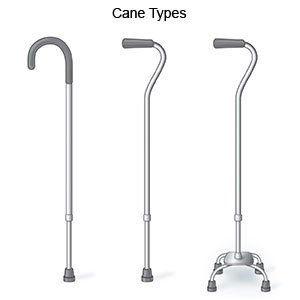How to Choose and Use A Cane
Medically reviewed by Drugs.com. Last updated on Apr 6, 2025.
What kind of cane should I choose?
Your healthcare provider will help you choose the right cane for your needs. Canes are made from wood, plastic, or metal. A cane can be adjusted to fit your height. The bottom of the cane usually has a nonskid rubber tip to prevent it from slipping. The following are common kinds of canes:
- Standard canes have a rounded crook handle. Use a cane with a wooden or plastic handle instead of metal. A metal handle may slip from your hand. In cold weather, the metal handle may get too cold for you to touch.
- Straight-handle canes , or T-handle canes, are used if your hand is weak.
- Broad-based canes are lightweight canes with 3 or 4 short legs. These legs give you the most support. You may need this type of cane if it is hard for you to keep your balance.

Drugs used to treat this and similar conditions
Lisdexamfetamine
Lisdexamfetamine systemic is used for ADHD, asperger syndrome, binge eating disorder, chronic ...
Dextroamphetamine
Dextroamphetamine systemic is used for ADHD, drowsiness, fatigue, narcolepsy, sexual dysfunction ...
Omvoh
Omvoh is used to treat moderate to severe ulcerative colitis or Crohn's disease in adults. This ...
Armodafinil
Armodafinil may be used to improve wakefulness in adults who are very sleepy due to narcolepsy ...
Duloxetine
Duloxetine is a selective serotonin and norepinephrine reuptake inhibitor antidepressant used to ...
Amphetamine/dextroamphetamine
Amphetamine/dextroamphetamine systemic is used for ADHD, fatigue, narcolepsy
Amantadine
Easy-to-read patient leaflet for amantadine. Includes indications, proper use, special ...
Methylphenidate
Methylphenidate is used to treat attention deficit disorder (ADD) and attention deficit ...
Modafinil
Modafinil promotes wakefulness and is used to treat excessive daytime sleepiness caused by ...
Isoxsuprine
Isoxsuprine systemic is used for cerebrovascular insufficiency, coronary artery disease, raynaud's ...
How do I use the cane?
- To walk on flat floors:
- Put the cane about 4 inches (10 cm) to the side of your stronger leg.
- Put weight on your stronger side.
- Move the cane about 4 inches (10 cm) in front of your stronger leg and bring your weaker leg forward at the same time.
- Use the cane to help keep your weight off your weaker leg and move your stronger leg ahead.
- Place your heel a little beyond the tip of the cane.
- To use on stairs: Ask your healthcare provider to show you how to safely use your cane on stairs. Do not use your cane on the stairs unless someone is with you.
- To get into a chair:
- Stand with the back of your legs against the chair seat.
- Rest the cane against the chair.
- Reach back with both hands to grip the chair arms.
- Lift your weaker leg slightly off the floor.
- Put all your weight on your stronger leg.
- Slowly sit down and slide back into the chair.
- To get out of a chair:
- Hold your cane with your stronger hand.
- Grasp the arms of the chair.
- Put your stronger foot a little forward.
- Lean slightly forward and push on the arms of the chair to raise yourself.
- Stand with your cane about 4 inches (10 cm) to the side of your stronger foot.
What are some cane safety tips I should know?
- Wear shoes with rubber soles , such as tennis shoes. Slippers should not be worn because they can slide off your feet and cause a fall. Do not wear shoes with leather heels or soles that may slide.
- Check the floor to be sure it is safe. The floor must be clean, dry, and well lit. Remove throw rugs to prevent falls. Tape or nail down loose carpet edges. Keep the traffic areas and the floor free of clutter.

- Stand for a few seconds before you start to walk with your cane. This will help prevent dizziness.
- Look straight ahead when you walk. You may run into or trip over something if you look at your feet.
- Use a backpack or a bag with a long strap that you can wear across your body. This will keep your hands free. Try not to carry heavy things.
Care Agreement
You have the right to help plan your care. Learn about your health condition and how it may be treated. Discuss treatment options with your healthcare providers to decide what care you want to receive. You always have the right to refuse treatment. The above information is an educational aid only. It is not intended as medical advice for individual conditions or treatments. Talk to your doctor, nurse or pharmacist before following any medical regimen to see if it is safe and effective for you.© Copyright Merative 2025 Information is for End User's use only and may not be sold, redistributed or otherwise used for commercial purposes.
Further information
Always consult your healthcare provider to ensure the information displayed on this page applies to your personal circumstances.
